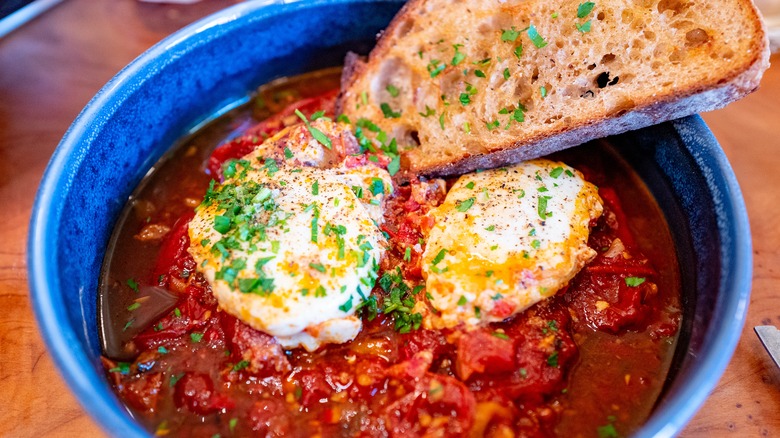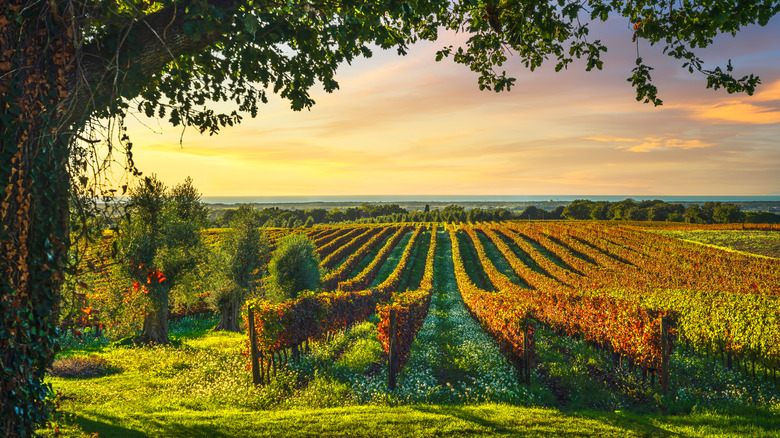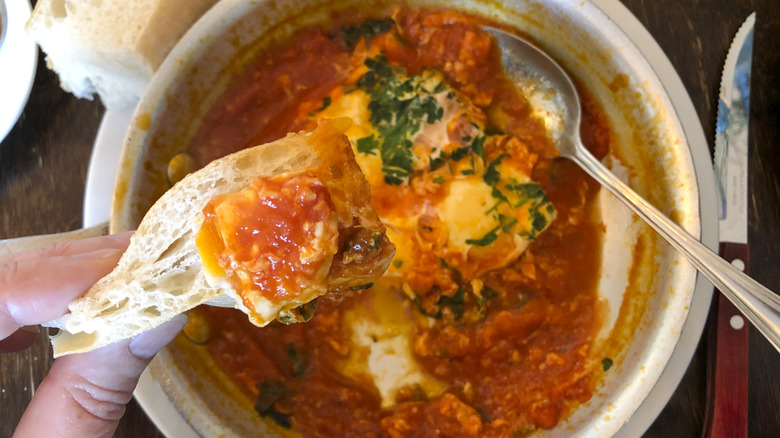The Tuscan Soup That's Name Literally Translates To 'Cooked Water'
Foodies might think "wine" when they think of Tuscany — but if you aren't thinking "soup," it might be time to think again. The region has birthed such classic beauties as zuppa toscana, pancotto, and ribollita, as well as another perhaps lesser-known soup that's name literally translates to "cooked water." Sound appetizing? Don't knock it till you try it.
Introducing: acquacotta, also colloquially called "Acquacotta Maremma." Per its namesake, the soup hails from Maremma, a coastal region in southern Tuscany that encompasses the Maremma Grossetana and Tuscia areas. Maremma is a historically poor region, thriving on subsistence agriculture, which has inadvertently led to some of the most enduring, beloved culinary developments in global food history. Tuscan cucina povera (aka "poor people's food") was the first culinary institution to pair pasta and tomatoes — and like many traditional cucina povera dishes, acquacotta is all about quality ingredients prepared well.
Despite its title, a lot more goes into acquacotta than cooked water. A slice of stale crusty bread is placed at the bottom of each serving bowl, and is then topped with a slow-stewed combination of tomatoes, onions, and chiles with shaved parmesan and a poached egg to garnish. The resulting soup is saucy and surprisingly rich — and a thrifty way to make use of bread that's a little past its prime.
Humble origins making history
Foodies have been enjoying acquacotta since the Middle Ages. Per the lore, the dish might have been invented by the butteri, a class of nomadic herders (aka pastoral Italian cowboys) who carried the sparse ingredients necessary to make the soup in leather sacks. The rest of the produce was gathered straight from the pastures as they rode. At the time, the butteri referred to acquacotta as minestra di sassi ("soup of stones") as a nod to how simple and versatile the dish was. The name "soup stone" also evokes the folktale where a magical stone is placed into a pot of soup and the soup becomes divinely greater than the sum of its parts. (Dolly Parton and Dr. Hook fans, rise up.)
Because of its humble origins and ragtag combination of ingredients, acquacotta varies wildly and doesn't have a single definitive recipe. Farmers and less-wealthy Tuscan home cooks incorporated whatever leftover veggies and herbs they had lying around into their acquacotta, so contemporary cooks should feel free to employ the same creative liberty as they make their own batches today.
Serve it up in style
All it takes to make acquacotta is a large stock pot or Dutch oven, a liquid component, and some fresh produce. Fresh or canned tomatoes will both work here; either red chile pepper or dried red chile flakes will similarly do the trick. You can use vegetable stock (bonus points if you make your own) or just plain water. Dry white wine adds a sharp pang of acidity to keep the profile dimensional and interesting. In the bottom of the pot, saute yellow onions and celery in olive oil, then add the rest of the ingredients and slow-simmer, stirring regularly.
To serve, top each bowl with a poached egg and shaved cheese. If you're fresh out of parmesan, pecorino romano works too. If your acquacotta starts to become too thick as it stews, add more water to taste. Allot for a little extra brothy-ness, as the slice of stale bread will soak up much of the liquid in the bowl.
Acquacotta is often served as a primo (first course), but it could also be paired with a side salad for a filling lunch. It's fitting to enjoy at any time of day, light and nutritional enough for breakfast but hearty enough for dinner. Plus, it's easy and low-cost to batch for a crowd, but just as easy to prepare in individual servings when you're only cooking for yourself.
Take a cue from the regional variations
This rustic, earthy soup makes a warming dish for icy winter days. But however you prepare it, the name of the game when it comes to acquacotta is "anything goes," and home cooks have created countless different versions over the centuries. There are regional variations even within Tuscany. In the Viterbo province, cooks add potatoes, chicory, and even cod.
Some cooks add bulk with white beans and escarole. Others use red wine or lemon juice instead of white wine; red onion can be used instead of yellow. For the produce, it isn't uncommon to see parsley, celery leaves, radishes, nettles, wild mustard, spinach, carrots, garlic, Swiss chard, or porcini mushrooms in the mix. Kick it Tuscany style and use indigenous cavolo nero and fresh basil. Acquacotta is also wickedly easy to transition into a vegan dish — simply substitute parmesan for vegan cheese and skip the poached egg.
Other cultures have created their own versions of acquacotta's thrifty, utility-based gastronomic genius. The dish is reminiscent of the African stewed-tomato-egg shakshuka, and stir-fried egg and tomato is a traditional Chinese dish. Today in Manhattan, Greenwich Village icon Caffè Reggio is serving an acquacotta-like "Tuscany soup," in which the slice of stale bread is turned into croutons. With so many variations available, it only makes sense to try as many as you'd like until you find your favorite!



